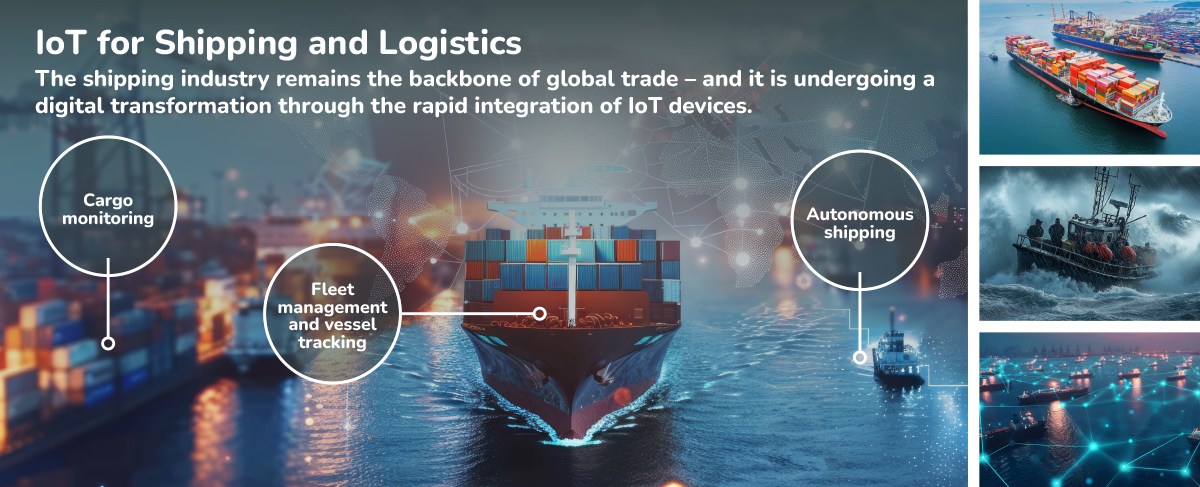IoT devices are transforming our approach to shipping logistics, vessel monitoring and marine life conservation. More advanced IoT technologies (with more reliable and powerful connectivity) have allowed for more innovative deployments that enable real-time data collection, improved operational efficiency, enhanced safety, and greater sustainability in a number of maritime industries.
Here, we explore some of the many applications of IoT in the maritime domain.

Fleet management and vessel tracking
Real-time tracking of vessels helps shipping companies to optimize routes, monitor fuel consumption, and minimize operational delays.
With environmental regulations becoming stricter across the globe, energy efficiency and emissions monitoring are now a priority for shipping companies. IoT devices allow for the continuous monitoring of fuel consumption, exhaust emissions, and energy usage on vessels and by leveraging this data operators can identify ways to optimize fuel efficiency, reduce greenhouse gas emissions, and comply with international environmental standards.
Predictive analytics powered by IoT can help forecast component failure, thus improving maintenance scheduling and reducing operational costs. Sensors embedded within the ship’s engine, hull, and other systems, can monitor vibration, temperature, and pressure levels, providing real-time insights into the engine's performance. This allows maintenance teams to identify early signs of wear and tear and, in turn, better schedule repairs and avoid unplanned downtimes.
Cargo monitoring
Shipping containers can be equipped with IoT sensors to monitor factors such as temperature, humidity, and vibration. This is particularly important for perishable goods like pharmaceuticals and fresh food, and data from sensors means that sensitive cargo can be stored safely during transit with alerts sent to operators if there is any deviation from preset optimal conditions.
Autonomous shipping
IoT devices are key to making autonomous vessels a reality. IoT sensors can provide data about environmental conditions, onboard systems, and even nearby vessels, which can help autonomous ships to navigate safely and efficiently without human intervention. These technologies could help shipping companies to lower labor costs, reduce human error, and increase the overall efficiency of maritime transportation.

Oceanographic research
IoT sensors deployed on buoys, underwater drones or autonomous underwater vehicles (AUVs) can gather vital real-time data on water temperature, salinity, pH levels, and pollutant concentrations. This data helps experts to better understand climate change and ocean acidification, and to quantify the harmful effects of pollution on marine life.
Wildlife tracking and protection Marine animals (including whales and dolphins) can be tagged with IoT-enabled devices such as GPS trackers or acoustic sensors to help researchers understand their behaviour and migratory patterns. The information gathered helps scientists identify critical areas for conservation and develop strategies to protect endangered species from threats like ship collisions, illegal fishing, and habitat degradation.
Smarter approaches to fishing
With the use of smart fishing devices such as sonar systems, tracking buoys, and automated fishing nets, the fishing industry can better monitor fish populations and avoid overfishing, helping to guide fishing practices that stay within sustainable levels and avoid irreparable damage to species and habitats.

Maritime safety
IoT-based monitoring systems on ships can help with early detection of hazards such as fire, flooding, or equipment malfunction. Integrated safety systems can send instant alerts to both the crew and onshore emergency response teams, meaning faster reaction times to critical situations.
Additionally, IoT technologies can allow for the remote monitoring of safety equipment such as life jackets, lifeboats, and fire extinguishers, ensuring they are in good condition and ready for use in emergencies.
Protection against piracy
Piracy remains a significant threat to maritime shipping. IoT-enabled surveillance devices, such as satellite tracking systems, cameras, and radar, can provide real-time location data and imaging to help shipping companies to adjust routes and provide updates to security forces, minimizing the risk of piracy-related incidents.
In summary
IoT devices are making the maritime sector safer, more efficient, and more sustainable.
Beyond the examples listed above, there are other innovative deployments for IoT in ocean exploration, storm tracking and more – and the potential applications for IoT devices in maritime contexts are only going to increase as technology evolves.
To support this burgeoning era of smarter and more connected oceans, developers need reliable and powerful batteries to power their devices.


